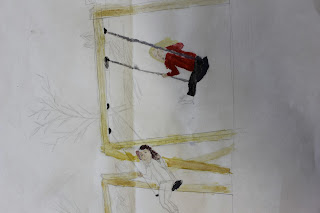Añadir un gadget
- Art (36)
- Games (27)
- Meeting in Barrafranca (3)
- Meeting in Boden 2011 (4)
- Meeting in Kerava (5)
- Meeting in Lleida (2)
- Meeting in Rugby (4)
- Others (7)
- Our Cities (11)
- Our Countries (11)
- Our musicians (39)
- Our Regions (5)
- Our Schools (6)
- The Project (3)
- Traditions (71)
Nov 15, 2011
SPANISH FOURTH GAME: LA BALDUFA
How to play with the Spinning top toy
There are different games you can play with your spinning top toy.On of them is the one is called:"How long?"
This is a game that you can play by yourself or with a group. When you play by yourself, make sure that you have a stopwatch handy. Clear a flat place where your top can spin freely, and then use your thumb and forefinger to start a spin. Once the spin has started, quickly start your stopwatch and time the length of your spin. When the top falls over, stop the stopwatch and note on a piece of paper how long it was before the top fell over. Try it again, looking to beat your previous time. If you are playing with a friend, you simply need to start spinning at the same time, and whoever has the longest spin wins the round.
Nov 14, 2011
ART FROM FINLAND: The human figure in the Romantic nationalism
Nov 13, 2011
ART FROM ITALY: The human figure in the Futurism
IL FUTURISMO
Il Futurismo, corrente artistica e culturale, nacque in Italia agli inizi del XX secolo.
Esso esaltava tutti gli aspetti legati al concetto di futuro, alla tecnologia e al progresso come la velocità, le macchine, le metropoli , le città industriali, le automobili, gli aeroplani, il culto per il coraggio, la giovinezza e la violenza.
Nella pittura e nella scultura, la figura umana viene rappresentata in movimento nello spazio e nel tempo o in forme meccaniche.
Abbiamo proposto agli alunni più artisti per far loro comprendere i diversi stili creativi per dare alla figura umana movimento e dinamismo.
THE FUTURISM
The Futurism, artistic and cultural movement, originated in Italy in the early 20th century.
It exalted all the themes associated with the concept of future, technology and progress, including speed, machines, metropolis, industrial cities, cars, airplanes, the cult of courage, youth and violence.
In painting and sculptur the human figure is represented in motion in space and time or in mechanical forms.
We have proposed to our chidren more artists to make them understand the different creative styles to give motion and dynamism to the human figure.
Nov 11, 2011
SPAIN:THE HUMAN FIGURE (CUBISM)
Nov 8, 2011
Between the two fires
Certificat de participació en la Setmana Comenius 2011

Sweden - Come visit us!
Click on the link down under for the coúntry dossier:
https://navet.boden.se/LotusQuickr/prastholmskolan/Main.nsf/h_Toc/888f058a3b7b5ecfc12571cc00469123/?OpenDocument#{type=0&unid=4CA9FD618C0CA388C1257941004F0AA2}
Nov 7, 2011
A swedish painter: Carl Larsson
Carl Larsson, 1853 – 1919,
He is one of Sweden’s most famous painters.
He is mostly known as an aquarellist.
He studied and worked for several years in Paris and in Grez,
where he made many of his most important paintings.
More information:
http://www.clg.se/enstart.aspx
Nov 1, 2011
Italian traditional game: "I quattru cantuneri"
Il gioco, adatto sia per le femminucce che per i maschietti, si svolge all’aperto in uno spazio di forma quadrata.
4 giocatori si posizionano negli angoli (cantoni) di un quadrivio e un giocatore si pone al centro in un punto equidistante ai quattro cantoni.
Al via i quattro giocatori si scambiano velocemente il posto muovendosi in diverse direzioni.
Il giocatore che sta in centro deve cercare di occupare un cantone lasciato libero dai compagni mentre si spostano.
Se ci riesce si posiziona nel cantone, mentre chi rimane senza cantone sta in centro.
I cantoni possono essere gli alberi, i pilastri, i pali oppure gli spigoli di una casa, che insieme formano un quadrato.
It is an outdoor game, suitable for boys and girls, played in a square area.
Four players take place in the corners of the square area and one player stays in the middle place equidistant from the corners.
When the game starts the four corner players exchange each other their place moving in different directions. The player who stays in the middle has to gain a free corner left by the players when moving.
If he succeeds he takes place in the corner, while the one without a corner goes in the middle.
The corners can be trees, pillars, poles or house corners forming a square.








